
- Homepage
- Conflict
- Format
- Albumen (3)
- Ambrotype (32)
- Cabinet Card (67)
- Cdv (5)
- Crayon Portrait (2)
- Daguerreotype (27)
- Hardcover (14)
- Multi-formats (6)
- Negative Photo Image (4)
- Photograph (6)
- Ruby Ambrotype (3)
- Sixth Plate (2)
- Small (2)
- Stereoview (3)
- Tin Type (8)
- Tin Type Photo (2)
- Tintype (157)
- Tintype Photograph (6)
- Unknown (9)
- ... (6650)
- Photo Type
- Album (9)
- Albumen (14)
- Ambrotype (199)
- Cabinet Photo (67)
- Cdv (479)
- Cdv & Tintype (6)
- Cdvs & Tintypes (7)
- Daguerreotype (84)
- Gelatin Silver (13)
- Mixed (3)
- Negative (10)
- Negative Photo (4)
- Opalotype (4)
- Other (4)
- Photograph (4)
- Snapshot (3)
- Stereoview (23)
- Tintype (525)
- Tintypes (3)
- Unknown (12)
- ... (5535)
- Theme
- Americana (41)
- Americana, Fashion (18)
- Americana, Militaria (17)
- Antique (8)
- Art (7)
- Civil War (14)
- Conflicts & Wars (6)
- Fashion (19)
- History (43)
- History, Militaria (10)
- Love (6)
- Militaria (1033)
- Patriotic (7)
- People (21)
- Politics (14)
- Portrait (67)
- Portrait, Man (22)
- Stamps (22)
- Travel (6)
- Victorian (7)
- ... (5620)
- Type
- Belt Buckle (3)
- Carte De Visite (2)
- Cdv (3)
- Cdv Photograph (14)
- Daguerreotype (3)
- Full Cdv Photo Album (2)
- Illustrated Book (3)
- Negative Film Photo (4)
- Pendant (3)
- Photo Album (3)
- Photo Frame (2)
- Photograph (1350)
- Photograph Album (49)
- Picture Book (8)
- Picture Frames (8)
- Print (3)
- Real Photo (rppc) (10)
- Tintype (9)
- Tintype Photo (4)
- ... (5525)
- Unit Of Sale
1860s Confederate Civil War Soldier Liberty Missouri Bushwhacker Colt Revolver
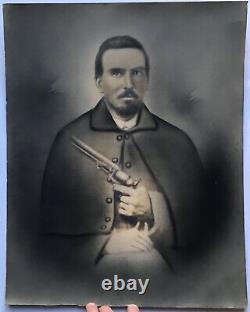
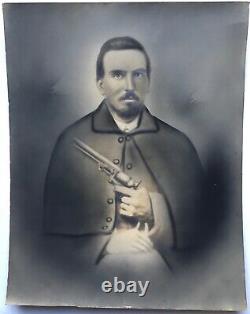
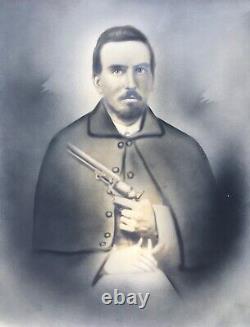
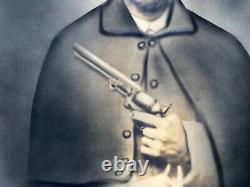
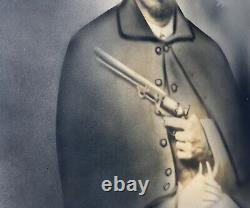
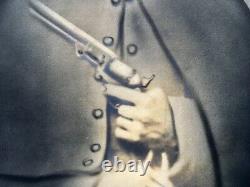
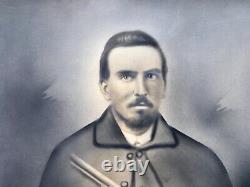
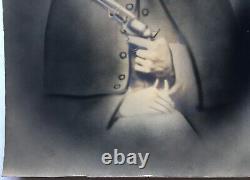
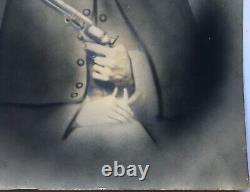
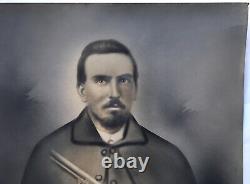

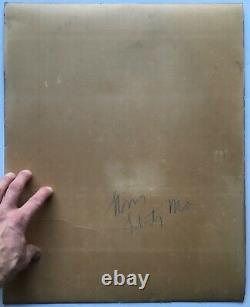


Tremendous antique 19th century, 1860s, large original Confederate Civil War soldier, or Missouri Bushwhacker, charcoal portrait photograph. These misunderstood portraits are often confusing. Is it a drawing or a photograph?
Hand-coloring dates back to the daguerreotype era of the 1840s. A bit of pink on the cheeks and a touch of gold made portraits more lifelike.Some photographers employed artists to color clothing too. The charcoal pictures are part of that hand-coloring tradition and they date from the 1860s into the early 20th century. There are various style for each period. Portraits enhanced with India ink, charcoal and crayons were primarily oversized and meant for display. This brilliant antique Civil War era image shows a seated Confederate soldier or Missouri Bushwalker wearing a light grey uniform under a grey Great Coat overcoat with brass?
He is proudly displaying his Colt Walker model revolver. He also appears to be clutching something in his right hand. The photograph is hand tinted with charcoal embellishments. Inscribed in period pencil on verso with a signature which I can not discern and a location of.
My first thought was perhaps a soldier who fought in the. Action At Blue Mills Landing.Provenance comes from a very old estate in the Kansas City, Missouri greater area. The portrait was salvaged from a period wood frame and is ready to be framed and preserved for future generations. No rips, breaks, holes, rips or tears. And other conflicts in which there were large areas of contested land and few governmental resources to control these tracts.
This was particularly prevalent in. During the Civil War where there were sharp divisions between those favoring the. The perpetrators of the attacks were called.The term "bushwhacking" is still in use today to describe ambushes done with the aim of. Bushwhackers were generally part of the. While bushwhackers conducted well-organized raids against the military, the most dire of the attacks involved ambushes of individuals and house raids in rural areas.
In the countryside, the actions were particularly inflammatory since they frequently amounted to fighting between neighbors, often to settle personal accounts. Since the attackers were non-uniformed, the government response was complicated by trying to decide whether they were legitimate military attacks or. The term "bushwhacker" came into wide use during the American Civil War. It became particularly associated with the pro-Confederate secessionist guerrillas of Missouri. Where such warfare was most intense.
Guerrilla warfare also wracked Kentucky. Including the new state of West Virginia. In some areas, particularly the Appalachian regions.
Of Tennessee and North Carolina. Was used for Confederate partisans. Used the name in the same manner. Several bushwhacker bands operated in California.Pro-Union guerrilla fighters in Kansas. They were involved in cross-border raids into Missouri. The action at Blue Mills Landing, also known as the Battle of Liberty, was a battle of the American Civil War.
That took place on September 17, 1861, in Clay County, Missouri. Union forces unsuccessfully attempted to prevent pro-Southern Missouri State Guards. From crossing the Missouri River.
Near the confluence with the Blue River. 4th Division, Missouri State Guard. Portrait measures 16" x 20". Please enjoy the photos for further item details and if you have any questions feel free to ask.
Thank you and be sure to check out our other listings! This item is in the category "Collectibles\Photographic Images\Photographs". The seller is "massachusettsantiques" and is located in this country: US.This item can be shipped to United States.
- Size: 16 x 20 in
- Photographer: Unknown
- Production Technique: Charcoal Photograph
- Framing: Framed
- Country/Region of Manufacture: United States
- Featured Person/Artist: Unknown
- Custom Bundle: No
- Style: Documentary, Photojournalism
- Material: Paper
- Theme: Civil War, Weapons, History, People, Portrait
- Format: Charcoal Photograph
- Type: Photograph
- Features: 1st Edition, Hand Tinted, One of a Kind (OOAK)
- Antique: Yes
- Number of Photographs: 1
- Vintage: Yes
- Image Orientation: Portrait
- Subject: Military
- Finish: Matte
- Signed: No
- Original/Licensed Reprint: Original
- Year of Production: 1861
- Image Color: Black & White
- Time Period Manufactured: 1850-1899
- Unit of Sale: Single Piece

